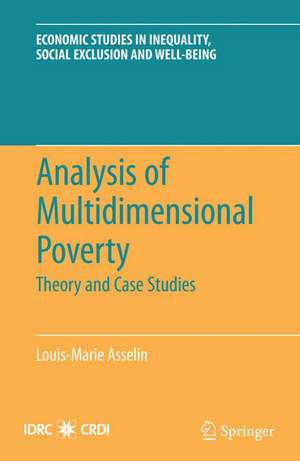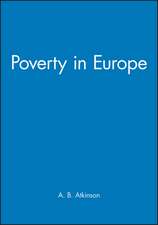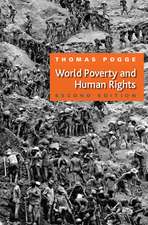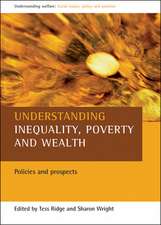Analysis of Multidimensional Poverty: Theory and Case Studies: Economic Studies in Inequality, Social Exclusion and Well-Being, cartea 7
Autor Louis-Marie Asselinen Limba Engleză Hardback – 19 aug 2009
Din seria Economic Studies in Inequality, Social Exclusion and Well-Being
- 15%
 Preț: 649.22 lei
Preț: 649.22 lei -
 Preț: 419.06 lei
Preț: 419.06 lei -
 Preț: 386.00 lei
Preț: 386.00 lei - 15%
 Preț: 646.75 lei
Preț: 646.75 lei - 15%
 Preț: 637.46 lei
Preț: 637.46 lei - 15%
 Preț: 579.52 lei
Preț: 579.52 lei - 15%
 Preț: 634.18 lei
Preț: 634.18 lei - 15%
 Preț: 696.82 lei
Preț: 696.82 lei - 15%
 Preț: 695.19 lei
Preț: 695.19 lei - 15%
 Preț: 641.53 lei
Preț: 641.53 lei - 18%
 Preț: 1229.40 lei
Preț: 1229.40 lei -
 Preț: 367.00 lei
Preț: 367.00 lei - 15%
 Preț: 653.98 lei
Preț: 653.98 lei - 15%
 Preț: 647.73 lei
Preț: 647.73 lei - 15%
 Preț: 640.06 lei
Preț: 640.06 lei - 18%
 Preț: 950.52 lei
Preț: 950.52 lei - 15%
 Preț: 640.06 lei
Preț: 640.06 lei - 18%
 Preț: 949.73 lei
Preț: 949.73 lei - 15%
 Preț: 646.94 lei
Preț: 646.94 lei
Preț: 947.50 lei
Preț vechi: 1155.48 lei
-18% Nou
Puncte Express: 1421
Preț estimativ în valută:
181.33€ • 188.61$ • 149.70£
181.33€ • 188.61$ • 149.70£
Carte tipărită la comandă
Livrare economică 15-29 aprilie
Preluare comenzi: 021 569.72.76
Specificații
ISBN-13: 9781441908421
ISBN-10: 1441908420
Pagini: 230
Ilustrații: XVI, 212 p.
Dimensiuni: 155 x 235 x 20 mm
Greutate: 0.5 kg
Ediția:2009
Editura: Springer
Colecția Springer
Seria Economic Studies in Inequality, Social Exclusion and Well-Being
Locul publicării:New York, NY, United States
ISBN-10: 1441908420
Pagini: 230
Ilustrații: XVI, 212 p.
Dimensiuni: 155 x 235 x 20 mm
Greutate: 0.5 kg
Ediția:2009
Editura: Springer
Colecția Springer
Seria Economic Studies in Inequality, Social Exclusion and Well-Being
Locul publicării:New York, NY, United States
Public țintă
ResearchCuprins
Theory.- Indicators and Multidimensionality Analysis.- Composite Indicator of Poverty.- Multidimensional Poverty and Inequality Analysis.- Conclusion.- Case Studies.- Case Study # Multidimensional Poverty in Senegal: A Nonmonetary Basic Needs Approach.- Case Study # 2 Dynamic Poverty Analysis in Vietnam 1993–2002: Multidimensional Versus Money-Metric Analysis.
Textul de pe ultima copertă
This book puts forward an operational methodology for measuring multidimensional poverty, independent from the conceptual origin, size and qualitative as well as quantitative nature of the primary indicators used to describe the poverty of an individual, household or socio-demographic entity. It allows for the integration of the sets of techniques already available or forthcoming in the area of income poverty into the analysis of multidimensional poverty. The core of the methodology rests on a solution to the issue of aggregation across the multiple sub-dimensions of poverty. The rationale of the proposed solution is based on the exploration of the internal structure of association between these sub-dimensions of poverty. The author illustrates the conceptual debates on the dimensions of poverty and on the measurement methodologies with empirical studies showing the strengths and weaknesses of different approaches by dividing the book into two parts. The first part, which is theoretical, develops the rationale underlying the proposed methodology with numerical examples. The second part presents two case studies, one from Vietnam and the other from Senegal, using the methodology outlined in the first part. Both case studies are based on large household surveys implemented by the different national statistical offices. The unique structure of this book makes it practical for use by poverty and policy researchers, professionals in international development, and graduate students interested in poverty and inequality.
Caracteristici
Unique structure allows for the methodology to be presented in the first part and its applications shown in two case studies in the second Methodology aims to be practical with the use of computational tools that are easily accessible and without any specific limitation on the number or the nature of the poverty indicators used by the analyst Case studies illuminate the applications of the operational methodology developed in part one A comprehensive definition of poverty and its ethical basis is proposed in an annex to the book


















